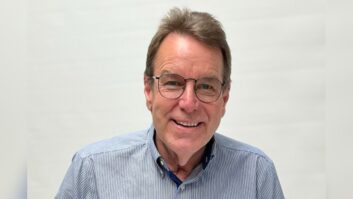This week a look at some computer information that might be of use to you.
When I graduated from Dover (Ohio) High School in the class of 1981, we had zero computers in the school. We still used mimeographs, overheads, 1/2-inch Sony video reel-to-reel decks, and had just gotten into Betamax and VHS. (Yes, I was an AV nerd and somehow, inexplicably, I was allowed by the school superintendent to take over a classroom and build it into a TV studio and control room).

Me (Dover shirt), David Barbie (fellow nerd) and Media Center Director Martha Blair in the “control room.”

The Dover High School TV Studio in Action
I started Ohio University in 1981 and was glad to have a Smith-Corona electric typewriter (with the latest in technology — back-space correction!), but still no computer. It wasn’t until about 1987 and while stationed in Madrid at Torrejon Air Base that the Air Force “strongly suggested” (they made me) learn computers!
I started with Sperry and Burroughs (then soon to be Unisys) computers and terminals. This certainly helped when our Armed Forces Radio & Television service station added a Broadcast Electronics Control 16 automation system (which was computer-based). Since then (now 30 years), computers have been a part of my life in all aspects of radio and TV, from the on-air work to engineering. There were many hours spent in a production studio editing 1/4-inch reel-to-reel tape on a splicing block and with a grease pencil and razor blade. Now I can’t image editing on anything less than a computer with Adobe Audition! You probably have a similar story if you’re over 50 years old. If you are under 40, you may not know of a time when a computer WASN’T a part of your life. As for my little girls (now 16 and 12 years old), they’ve naturally grown-up surrounded by computers, processors, the internet, and are fully immersed in this digital world.
For this Off the Beaten Path, I’m going to point out a few links to information related to computers (obviously there is a TON of information available, but these are links that I think might be more timely). At the NAB convention last April, I was at one manufacturer who had some very cool “widgety gear” which was very reasonably priced. Clearly it had significant “processing power” behind it. When I inquired as to what was “driving” the product, it turned out to be Raspberry Pi3 technology.
Now if you don’t know what that is (and note that there are similar products like it), you should become familiar. Originally developed in England, the Raspberry line is based on ARM central processors — small, stripped-down computers-on-a-chip that are customized to do only a few things, but do them very well. Unlike Windows or OSX on PCs and Macs (respectively), these processors use open source operating systems, so this automatically drops the price of using them by a few hundred dollars (that Microsoft and Apple aren’t getting).
Along the same “think small” approach, we’re also seeing parts from a computer parts OEM called Arduino integrated in processor-based broadcast gear. For instance, Skaarhoj (a Danish company) is producing controllers for video equipment (Blackmagic Design gear) which is very interesting. One piece of gear takes house sync and lays an Arduino-based digital signal on top of that sync and feeds it into the Blackmagic cameras so that shading (iris, coloring, video levels, pedestal, etc.) can be controlled without any additional cabling.
So as you look at these links, you might think about the prospect of very inexpensive processing and how it might affect not only radio and TV gear, but things around your house.
Windows 10
Let’s start with one of our most common OSes, Windows. Microsoft has an update coming out very soon for Windows 10. This “Creators update” has some updates which look interesting in terms of productivity. I personally would like to see Cortana (the annoying search engine) dumped or at least NOT have its “meat hooks” in everything, plus the “ever-locking-up” Edge fixed. Edge is their latest browser that seems like it loves to lock-up computers.
Raspberry Pi
These wee little computers (now on v.3) were originally designed as teaching aids. However, developers quickly, found they could be made to do lots of things a “regular computer” (a Windows or Mac) could do, if you could do a little programming. As mentioned, I’ve already seen these integrated into new broadcast gear. It’s interesting to note that the basic Pi board can have a processor, working memory, memory card slot (their system, energy- and space-efficient substitute for the traditional hard drive), a couple of USB ports, an HDMI port (for video display) and expansion bus. The Raspberry Pi works off of open source operating systems (numerous different systems can be installed like Raspbian, Fedora, Ubuntu, and many others).
Arduino
As mentioned earlier, Arduino, originally from Italy, is an open-source computer hardware and software company with an eponymous project similar to Raspberry Pi that allows users to program microprocessors to do things a more traditional computer would do but at a fraction of the price. Unlike Raspberry Pis, Arduino is more of a processing card than a full-scale (miniature/micro) computer.
Arduino “Boot Camp”
Though this isn’t free ($14), I did find an “Arduino 101” (basics) boot camp that gives an introduction to Arduino.
Computers for Kids
Many of us had our starts with Knight-Kits, Heathkit, and the Radio Shack “101 Project Kit” for our introduction to basic electronics (I STILL have my original 101 kit!) If you have young kids or grandkids who you’d like to put on the path to “nerd-dom,” grab some old Star Trek episodes and sit them down behind this little Piper Computer Kit ($299).
Computers: The Next Generation
Here’s another interesting link from the web site interestingengineering.com. The future of computers may bring “Quantum” computers into our lives. In theory, these are computers that use subatomic particles for storing information. If you’d like to learn more, here’s the link.
And Finally …
This is a website with themed collections of great photos. It’s called “Groovy History.” This particular link foes to a collection of great old photos of people (some famous before they were famous). If you are looking for something to skim through over lunch, this is great for that!
If you stumble across a good or unusual website that might be of interest, please don’t hesitate to send me the link and any info you might have about it. My email address is [email protected].











